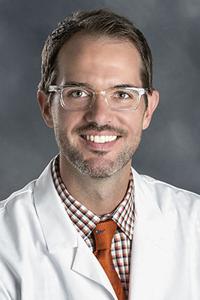Table of Contents
Credits
Hosts: Jeremy Steinbruck, Sara Dong
Guest: Nicholas Gilpin
Writing: Jeremy Steinbruck, Sara Dong
Producing/Editing/Cover Art/Infographics: Sara Dong
Our Guests
Guest Co-Host
Jeremy Steinbruck, MD

Dr. Jeremy Steinbruck completed his undergraduate training at University of Massachusetts Boston. He then earned his medical degree in Dominica at Ross University School of Medicine, where he did clinicals at Far Rockaway NY and Michigan. He completed residency at Carilion Clinic in Roanoke, VA, and he is now back in Michigan for his first year of ID fellowship at Beaumont Royal Oak
Guest Discussant
Nicholas Gilpin, DO

Dr. Nick Gilpin is an infectious disease physician with Beaumont Health, an 8-hospital healthcare system located in southeast Michigan. He currently serves as the Medical Director of Infection Prevention and Epidemiology for Beaumont Royal Oak, a 1,131-bed major academic and referral center with Level I adult trauma and Level II pediatric trauma designations. He is also the Medical Director of Infection Prevention for the Beaumont Health System.
Dr. Gilpin earned his medical degree from Michigan State University College of Osteopathic Medicine in 2006. He completed an internship and residency in internal medicine at Ascension St. John Providence Hospital in Southfield, MI from 2006 to 2009, and he completed his infectious diseases fellowship training at Beaumont Royal Oak in 2011. Dr. Gilpin is currently an assistant professor with the Oakland University William Beaumont School of Medicine and the Michigan State University College of Osteopathic Medicine.
Consult Notes
Consult Q
65 yo female s/p ex-lap for colorectal fistula repair who developed fevers, chills, and now has new CT abd/pelvis with abscess. Assistance with antibiotic management.
Key Points
The HAI School Series! HAI = Healthcare Acquired Infections
This episode is #3 of 4 in another Febrile series, this time entitled “HAI School”! This bundle of episodes will discuss some healthcare associated infections (CLABSI, CAUTI, SSI, and VAP). Check out all four episodes (#60-63) to hear them all! The first three are from a team from Beaumont Health, and the fourth episodes features a team from the University of Michigan
Let’s start with the basics! What is a surgical site infection (SSI)?
- The CDC definition of SSI is the most used = an infection related to a surgical procedure that occurs near the surgical site within 30 days following surgery (or up to 90 days following surgery where an implant is involved)
- SSIs are divided into:
- Superficial incisional SSI: those involving only skin and subcutaneous tissues
- Deep incisional SSI: involving deeper soft tissues of incision (such as fascia, muscle layers)
- Organ/space SSI: any part of body deeper than fascia/muscle layers that was opened or manipulated during procedure
- Berríos-Torres SI, Umscheid CA, Bratzler DW, et al. Centers for Disease Control and Prevention Guideline for the Prevention of Surgical Site Infection, 2017 [published correction appears in JAMA Surg. 2017 Aug 1;152(8):803]. JAMA Surg. 2017;152(8):784-791. doi:10.1001/jamasurg.2017.0904
- NHSN = CDC’s National Healthcare Safety Network (NHSN), which is a HAI tracking system
- Here’s the NHSN document with more details on surgical site infection events, updated Jan 2023
- There are other tools that have been used to describe SSIs, such as the two below, but this may not be easy to use outside of research settings
- ASEPSIS (Additional treatment, the presence of Serous discharge, Erythema, Purulent exudate, and Separation of deep tissue, the Isolation of bacteria, and duration of inpatient Stay)
- Wound Healing Questionnaire
Epidemiology, Risk Factors, and Impact of Surgical Site Infections
- SSIs are associated with significant morbidity and mortality, transfer to ICU setting, prolonged hospitalizations, and readmissions
- Among those who undergo surgical procedures annually in the US, 2-4% will develop an SSI. The incidence varies widely and depends on the operative site and wound classification
- Risk factors:
- The risk of SSI varies by procedure, with the highest rates after abdominal (particularly colon) surgery [~10%]
- The degree of contamination of the surgical wound at time of operation (more on this below)
- Risk factors for poor wound healing are also risk factors for SSI: cigarette smoking, vascular disease, older age, obesity, diabetes, immunosuppressive therapy
- Local wound factors such as edema, presence of recent or remote infection at surgical site
- To check on the latest data, you can access some info at the CDC website, such as:
- Current National and State HAI Progress Report, where data tables and summaries are available
- National and State Factsheets are available at the Antibiotic Resistance & Patient Safety Portal
- Additional resources:
- Lewis SS, Moehring RW, Chen LF, Sexton DJ, Anderson DJ. Assessing the relative burden of hospital-acquired infections in a network of community hospitals. Infect Control Hosp Epidemiol. 2013;34(11):1229-1230. doi:10.1086/673443
- FALCON study found risk factors in their population of no antimicrobial prophylaxis, high proportion of emergency cases, current smoking. SSI in middle to low income countries may be higher compared to high income countries: NIHR Global Research Health Unit on Global Surgery. Reducing surgical site infections in low-income and middle-income countries (FALCON): a pragmatic, multicentre, stratified, randomised controlled trial. Lancet. 2021;398(10312):1687-1699. doi:10.1016/S0140-6736(21)01548-8
- Anderson DJ, Podgorny K, Berríos-Torres SI, et al. Strategies to prevent surgical site infections in acute care hospitals: 2014 update. Infect Control Hosp Epidemiol. 2014;35(6):605-627. doi:10.1086/676022
Surgical wound classification
- Jeremy and Nick briefly touched on surgical wound classification during the episode. The degree of contamination of a wound at the time of operation is an important risk factor for infection
- The NHSN classifies wounds as:
- Class I / Clean:
- Uninfected operative wound in which no inflammation is encountered and the respiratory/alimentary/genital/or uninfected urinary tract is not entered
- Primarily closed wound and if necessary, drained with closed drainage
- Class II / Clean-contaminated
- Wound in which respiratory/alimentary/genital/or urinary tracts are entered under controlled conditions and without unusual contamination
- Operations involving biliary tract, appendix, vagina, and oropharynx are included provided no evidence of infection
- Class III / Contaminated
- Open, fresh, accidental wounds
- Operations with major breaks in sterile technique (eg, open cardiac massage) or gross spillage from GI tract
- Incisions in which acute, nonpurulent inflammation is encountered
- Class IV / Dirty/Infected
- Old traumatic wounds with retained devitalized tissue and those that involve existing clinical infection or perforated viscera
- This definition suggests that the organisms causing postoperative infection were present in the operative field before the operation
- Based on ACS surgical wound classification: https://stacks.cdc.gov/view/cdc/7160
- Class I / Clean:
- SSIs occur in ~4% of clean wounds and 35% of grossly contaminated wounds
Microbiology of SSIs
- Predominant SSI organisms after clean procedures will be skin flora (such as Strep spp, Staph aureus, and coagulase-negative staphylococci)
- Clean contaminated procedures: GNRs, Enterococci, skin flora
- Viscus: pathogens reflect endogenous flora of viscus or nearby mucosal surface, usually polymicrobial
- Resources:
SSI Management
- In general, management will consist of wound exploration and debridement (as necessary), ongoing wound management, and antimicrobial therapy.
- We won’t focus on the specific antimicrobial selection here given the approach will vary by case and location
Preventing SSIs
- Infection control programs/interventions are an essential part of SSI prevention, and prevention strategies can be bundled for improved adherence
- Here are some of important tools/factors:
- Timely administration of effective prophylactic antibiotics
- Use of a surgical time-out improves compliance
- Hand hygiene!
- Preop cleansing of hands and forearms with antiseptic agent
- Removal of false nails, watches, and rings
- Appropriate surgical attire & barrier devices (gloves, scrubs, barrier devices like masks/caps/gowns/drapes/shoe covers)
- Careful attention to operative technique
- Proper skin preparation with antiseptics (to reduce burden of skin flora)
- Hair removal by clipping instead of shaving
- Surgical techniques, such as: Gentle traction, effective hemostasis, removal of devitalized tissues, obliteration of dead space, irrigation of tissues to avoid excessive drying, wound closure without tension, minimizing duration of closed-suction drainage
- Maintenance of sterile conditions:
- Operating room cleanliness and disinfection
- Limit traffic in the operating room
- Glucose control
- Providing surveillance and reporting rate of SSIs
- Timely administration of effective prophylactic antibiotics
- Don’t forget about pre-surgery considerations, such as the timing of surgery:
- Avoid elective surgery in patients with active infection
- Other factors to consider with surgical planning/scheduling might include: emergency surgery (are there any temporizing measures possible?), cancer/radiation/immunosuppressive therapies, remote infection, malnutrition
- This is not an exhaustive list, but highlights some of the important items. You can read more in the resources below:
- WHO Global Guidelines for Prevention of Surgical Site Infection
- Berríos-Torres SI, Umscheid CA, Bratzler DW, et al. Centers for Disease Control and Prevention Guideline for the Prevention of Surgical Site Infection, 2017 [published correction appears in JAMA Surg. 2017 Aug 1;152(8):803]. JAMA Surg. 2017;152(8):784-791. doi:10.1001/jamasurg.2017.0904
- O’Hara LM, Thom KA, Preas MA. Update to the Centers for Disease Control and Prevention and the Healthcare Infection Control Practices Advisory Committee Guideline for the Prevention of Surgical Site Infection (2017): A summary, review, and strategies for implementation. Am J Infect Control. 2018;46(6):602-609. doi:10.1016/j.ajic.2018.01.018
- Ban KA, Minei JP, Laronga C, et al. American College of Surgeons and Surgical Infection Society: Surgical Site Infection Guidelines, 2016 Update. J Am Coll Surg. 2017;224(1):59-74. doi:10.1016/j.jamcollsurg.2016.10.029
- Liu Z, Dumville JC, Norman G, et al. Intraoperative interventions for preventing surgical site infection: an overview of Cochrane Reviews. Cochrane Database Syst Rev. 2018;2(2):CD012653. Published 2018 Feb 6. doi:10.1002/14651858.CD012653.pub2
- Anderson DJ, Podgorny K, Berríos-Torres SI, et al. Strategies to prevent surgical site infections in acute care hospitals: 2014 update. Infect Control Hosp Epidemiol. 2014;35(6):605-627. doi:10.1086/676022
- Best Practice in Surgery (BPS) SSI Prevention Page [Canada]
- National Institute for Health and Care Excellence (NICE) SSI: Prevention and Treatment [UK]
Infographics
Goal
Listeners will be able to understand the definition, evaluation, and management of surgical site infections
Learning Objectives
After listening to this episode, listeners will be able to:
- Define surgical site infections (SSIs)
- Describe strategies to prevent CLABSI
Disclosures
Our guests (Jeremy Steinbruck and Nicholas Gilpin) as well as Febrile podcast and hosts report no relevant financial disclosures
Citation
Gilpin, N., Steinbruck, J., Dong, S. “#62: HAI School: A Febrile Bundle on Healthcare-Associated Infections #3 – InSSIght into SSIs”. Febrile: A Cultured Podcast. https://player.captivate.fm/episode/651c6666-42dd-46e2-88d0-20d00657e88f


